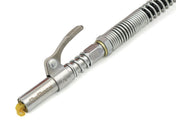Why Testing Matters in Lubricant Selection
When it comes to choosing the right lubricant for high-load and high-pressure applications, not all greases and oils are created equal. Engineers and maintenance professionals cannot rely on product labels alone - they depend on standardised test data.
One of the most trusted and widely used methods for evaluating extreme pressure (EP) performance is the 4-Ball Weld Test however you need to evaluate this result along with other results to get the full picture.
What Is the 4-Ball Weld Test?
The 4-Ball Weld Test is a standardised method used to evaluate both the extreme pressure (EP) performance and the anti-wear properties of lubricants. It’s particularly important for EP greases and industrial oils. This test determines how effectively a lubricant prevents metal-to-metal contact under high loads. How Does the 4-Ball Weld Test Work?
How Does the 4-Ball Weld Test Work?
Test Setup
- Three steel balls are fixed in a triangular cup.
- A fourth ball is placed on top and rotated under load.
- Standardised ½" steel balls are always used.
- The lubricant is applied between the balls.
Test Procedure
- The top ball rotates against the three stationary balls.
- Load is progressively increased until welding occurs.
Goal
Identify the Ok Load & weld point - the load (measured in kilograms or newtons) at which the balls weld together because the lubricant film fails.
What Is the OK Load?
The OK Load is the maximum load a lubricant can withstand before welding occurs. It represents the point just before catastrophic failure due to metal-to-metal contact.
Why the OK Load Matters
The OK Load is a critical performance indicator for EP lubricants. It provides:
- Confirmation of EP capability - Shows how much load the lubricant can endure before failure.
- Real-world reliability - Predicts performance in heavy-duty equipment, gearboxes, and shock-load environments.
- Maintenance support - Reduces risk of wear, downtime, and costly repairs.
- Product comparison - Enables fair side-by-side evaluations.
 Why Omitting the OK Load Is Misleading
Why Omitting the OK Load Is Misleading
If the OK Load value is missing, users cannot confirm whether a lubricant is truly capable of handling demanding applications.
For example: a lubricant might advertise a Weld Load of 7000 N. However, if the OK Load is not reported, there’s no way to determine at what point damage actually began. The lubricant could have started failing at just 4000 N, but without the OK Load or LWI value, we simply can’t know.
This omission allows brands to highlight an impressive weld result while conveniently avoiding the full picture. It’s a misleading tactic - technically not a lie, but far from transparent.
Why some brands leave it out:
- Their product may have failed the test.
- Results were too low to compete.
- They want to avoid scrutiny from informed buyers.
For maintenance professionals, missing data should always raise a red flag. All KAJO spec sheets show the OK load and Weld Load.
Our KAJO LC002 - Backed by Verified Data
At KAJO, we believe in transparency and performance you can trust. Our KAJO LC002 is a high-quality, high-temperature, multipurpose, roller-bearing, long-life EP grease.
Here’s the verified test data:
- 4-Ball OK Load: 2400 N
- 4-Ball Weld Load: 2600 N
What This Means
- OK Load (2400 N): The grease withstands up to 2400 newtons before the film begins to fail.
- Weld Load (2600 N): Even under extreme stress, KAJO LC002 protects right up to the point of metal welding.
This makes KAJO LC002 a reliable choice for demanding applications where downtime is not an option.
Conclusion: Trust the Data, Not Just the Label
When selecting an EP grease, marketing claims are not enough. The 4-Ball Weld Test and OK Load values provide objective, measurable proof of how a lubricant performs under extreme pressure.
With KAJO LC002, you get verified results, reliable performance, and the confidence that your equipment is protected.
Choose data. Choose reliability. Choose KAJO & next time check for OK LOAD or Load Wera Index (LWI)!



